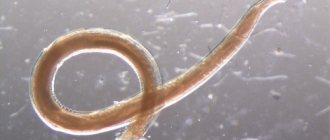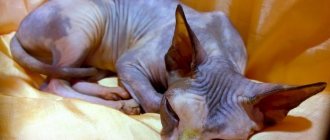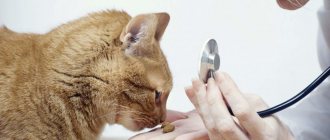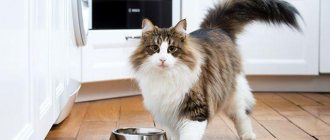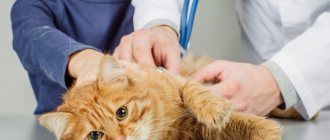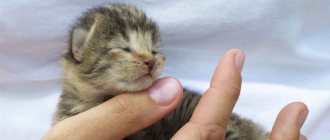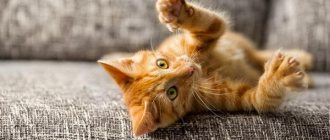6333Administration
In cats with long hair, the reason that it moves on the floor is the remains of feces under the tail. If during the process of defecation a cat has problems with bowel movements, the animal rides on its tail and tries to squeeze out the remaining feces from the intestines and clean the anus. This can happen if the stool is too thick.
© shutterstock
In addition, it can get tangled in the animal's thick fur and create discomfort. Then the cat cannot get rid of feces. She will try to do this, and rides her butt on the rough surface. The cat rolls its butt on the carpet, because in this case the carpet is the most suitable option.
Too loose stool is also the reason that the cat moves around and wipes its butt on the floor. Diarrhea causes irritation of the anus itself and the skin around it in short-haired breeds. The cat cannot reach this place with its paw. The only way she can get rid of the painful sensation of itching is to sit on her butt and move her front paws and walk along the floor.
Dietary disorders that cause your cat to have constipation or loose stools can be corrected with an appropriate diet and sufficient water. For long-haired beauties, it is recommended to trim the fur near the anus so that feces do not remain in the fur. For diarrhea, the cat is given rectal suppositories to relieve inflammation in the rectum.
Behavioral instincts
Most cats turn out to be real clean people and are willing to spend a lot of time licking their fur. This behavior is driven by natural instincts:
- Cleaning up after the hunt . Cats are predators, so after meals they need to remove the blood of their “prey” from their coats.
- Calming effect . This procedure calms the animal and relieves stress. It is believed that by cleaning the fur with their tongue, cats lick vitamin B from it, which is necessary for normalizing psychological balance.
- Disguise method . Washing is not just a standard ritual; cats use it to mask their scent. This allows wild animals to remain undetected for as long as possible during the hunt.
- Protective reflex . With their rough tongue they distribute fatty lubricant - secretory lard, which protects the coat and gives it elasticity.
- Purity. Licking is also a hygienic procedure, as a result of which cats keep their fur clean, including in the intimate area.
Fur coat length. As a rule, hairless and short-haired pets are easier to care for their skin and coat.
But the owners of a luxurious, long fur coat are less fortunate. Often, access to “that very” place is difficult for them. And if a long-haired pet suddenly begins to “ride” along the floor on the “fifth point”, choosing rough surfaces, then it is worth looking under its tail and assessing the condition of the fur in this place. Perhaps dirt, fecal particles have stuck to it, tangles have appeared, or foreign objects, such as plant twigs, have become stuck.
Washing
This procedure can only be performed by a specialist. It is indicated for significant inflammation, when there is suppuration and a through hole is formed.
It is important to know that treatment at this stage will take a long time, and recovery is not guaranteed. You will have to resort to the procedure constantly in order to at least slightly reduce the animal’s pain.
Washing consists of the following steps:
To prevent the cat from licking itself, a collar, diaper or blanket is put on it.
Diarrhea is one of the reasons for “riding on the butt”
Cats suffering from diarrhea may clean their butts on the flooring, carpet or other rough surface. In this case, the behavior of the animals has nothing to do with the quality and length of their fur. Thanks to friction, the pet tries to solve two problems at once:
- Get rid of extraneous, unpleasant odor.
- Eliminate itching sensations that occur due to irritation of the mucous membrane in the anal area.
Treatment. When the cat does not have frequent bowel movements, but is bothered by itching, veterinarians recommend using rectal suppositories that have enveloping and antibacterial properties.
During the recovery period, the animal should not push too hard, so it is prescribed a light diet.
Who is susceptible to the disease
Most often, the pathology is observed in young males, but it is not uncommon for cats to suffer from this problem. Inflammation is especially common among long-haired animals.
In addition, the following animals are at risk:
- leading a sedentary lifestyle;
- pregnant cats;
- injured in the anus;
- those who eat poorly and are prone to diarrhea or constipation;
- with obesity.
Possible pathological disorders
Unfortunately, diarrhea and dirty fur are not the only factors that cause a cat to ride on its butt. There are also more serious factors that lead to this behavior, for example:
- mental health disorder;
- post-traumatic stress disorder;
- helminthic infestation;
- paraanal inflammation.
Each of the diseases deserves attention and requires consultation with a veterinarian. In addition, they are accompanied by other symptoms, in addition to “travels on the fifth point”.
Signs of mental disorder
With mental disorders caused by stress, the pet's behavior changes noticeably and becomes strange. The cat can:
- show aggression;
- avoid communication, including with the owner;
- lose appetite.
The owner may notice that the pet begins to crawl on the floor, regardless of toilet procedures. In this case, it is recommended to immediately contact a specialist who will identify the pathology and prescribe appropriate therapy.
Phantom pain syndrome
After an injury to the hind legs or a fracture of the hip joint, the pet begins to look for a way to eliminate phantom soreness. He rolls on the floor, trying to get rid of the pain that is lingering in his brain. In such a situation, veterinarians prescribe medications that have a mild sedative effect to the animal. They help him cope with excruciating post-traumatic discomfort.
Parasite infestation
Most often, pets get pinworms and tapeworms, which live in the large intestine. To reproduce, many of them have to crawl to the entrance to the anus to lay eggs. This process is accompanied by a feeling of severe itching, which the pet tries to get rid of by crawling on the floor.
When infected with tapeworms, a feeling of bloating occurs in the intestines. The cat strives to get rid of feces, stimulating the anus while riding on the floor and causing defecation. To save your pet from such difficulties, you should regularly deworm it, using anthelmintic drugs for preventive purposes. These can be tablets for oral administration, drops on the withers area or other means.
Blockage of the anal glands
Mustachioed striped animals have anal glands, which are muscular sacs located in close proximity to the anus. They constantly produce secretions that are released through the ducts during bowel movements. It gives feces and urine a specific odor, allowing cats to leave “fragrant” marks on their territory.
Norm and deviations. In its normal state, the secretion is a thick, odorous substance. If the glands are not completely emptied, then corresponding disorders arise:
- the tissues of the muscle sacs are “overstretched”;
- irritation occurs in the glandular ducts;
- dermatological problems arise - small inflamed seals and bald spots form in the neck and along the spine;
- the paraanal glands swell greatly and become visible under the animal’s tail.
Consequences. If the owner does not pay attention to the blockage in time, then the disruption of circulation ends with the formation of a fistula and the penetration of the contents of the glands into the peritoneum.
Treatment
Inflammation of the paraanal glands in a cat can be eliminated quite simply, although this procedure is unpleasant for owners. Its essence is to squeeze out the accumulated liquid. If this procedure causes pain to the animal, it is necessary to conduct a seven-day course of antibiotic injections with Novocaine.
In difficult cases, you have to use the services of specialists - if necessary, wash the bags with special solutions. If it comes to an abscess, it must be opened, cleaned and the purulent wound treated.
If inflammation of the paraanal glands in cats, the causes of which were mentioned above, has become chronic, and the bags have to be emptied manually too often, a specialist may suggest simply removing them. These organs do not carry a significant functional load, so their absence will not affect the life and well-being of the pet in any way.
We suggest you read: Can chickens be given red beets?
https://www.youtube.com/watch?v=ytpress
Of course, this decision should only be made by an experienced specialist.
Poor diet and low mobility
Common factors leading to butt riding include:
- physical inactivity;
- excess body weight;
- high-calorie foods.
Unfortunately, even among cats there are often lazy people who lead a sedentary lifestyle. With obesity and low activity, changes occur in the animal’s body and the place of muscles is replaced by a fat layer. The tissues are compressed and the circulation of the anal ducts is disrupted.
Excess calories affect the functions of internal organs, which leads to the development of diarrhea. With frequent bowel movements, the odorous secretion does not mix with feces, remaining on the skin, causing irritation and itching. And in this case, the pet will ride on the floor, trying to reduce discomfort.
What to do?
Examination and normalization of nutrition
If your cat's butt is swollen and painful, it is important to take your pet to the veterinarian as soon as possible. First of all, the veterinarian will conduct a survey, during which he will find out how long ago the problem was noticed, whether there are additional symptoms
Then the doctor examines the perianal area, after which he prescribes a general and biochemical blood test for the kitten, as well as a stool test. Sometimes x-rays, colonoscopy and ultrasound examination of the abdominal cavity are required.
It is important that the food consumed by the animal contributes to the normal digestion process. After diagnostic measures, the veterinarian makes an accurate diagnosis and prescribes the required treatment
In most situations, your kitten will need to change their diet. Your pet's menu should include a sufficient amount of foods that contain vitamins and minerals, and help improve metabolism and enhance peristalsis. Foods containing fiber and bran will be beneficial.
After diagnostic measures, the veterinarian makes an accurate diagnosis and prescribes the required treatment. In most situations, your kitten will need to change their diet. Your pet's menu should include a sufficient amount of foods that contain vitamins and minerals, and help improve metabolism and enhance peristalsis. Foods containing fiber and bran will be beneficial.
Carrying out therapy
If a kitten's inflamed bottom is caused by a helminthic infestation, therapy should include the use of anthelmintic medications. When the problem is caused by an autoimmune reaction of the body, they resort to the help of immunosuppressants and anti-inflammatory pharmaceuticals. When the inflammatory process is advanced, the pet is put on a starvation diet. For 2 days, the pet is only allowed to drink. These measures are required to restore the epithelial layer of the final part of the digestive tract.
A serious problem for your pet can be rectal prolapse, which can only be corrected by a specialist.
Rectal prolapse can also cause the problem. If this happens, the first thing the pet owner needs to do is wrap the kitten’s butt in a clean cloth that has been previously moistened with warm water.
This precaution will help protect the intestines from damage.
Then it is important to take the animal to the veterinary clinic as quickly as possible. In most situations, conservative treatment is prescribed
The veterinarian treats the intestine with a solution of potassium permanganate, and then lubricates it with novocaine ointment. Next, the doctor carefully adjusts it and stitches it so that the feces come out freely. The stitches are removed after 5 days. If the kitten was not delivered to the veterinary clinic on time and necrosis began, surgical intervention will not be possible. During the process, dead tissue is cut off and the intestine is sutured to the wall of the peritoneum.
Metabolic disorder
Failures in metabolic processes lead to various disturbances in the functioning of the animal’s body. As a result, the consistency of secretory secretions often changes; they can become too thick and clog the ducts. Sometimes the glands begin to secrete more secretions than usual. In both cases, the skin becomes irritated, inflammation, swelling and itching occur. If the pet is not helped, then the risks of developing complications are high:
- The animal begins to actively move along the floor, which causes damage to the skin near the anus.
- The wounds become infected and an inflammatory process develops. The most dangerous thing is infection of ulceration by pathogenic bacteria.
- If left untreated, the inflammatory process spreads to the peritoneum.
Such violations lead to the pet becoming too restless. He can't find a place for himself and drives furiously at the fifth point.
If an animal has a weakened immune system, then there is a risk of developing infectious blood poisoning.
Also watch the video why a pet rides on its butt:
Why do kittens have a problem?
Irritation of the perianal area is often caused by proctitis. This disease can occur in cats of any age, gender and breed. Small kittens are not immune from its occurrence. In addition, a bulging and swollen butt in a cat can also be observed due to the influence of the following most common factors:
- intoxication of the body;
- helminthic infestation;
- infectious diseases;
- fungal infection of the body.
A kitten's inflamed bottom is often caused by rectal prolapse. During the development of this pathological condition, either the entire or a small part of it can protrude through the anal passage. The following factors can provoke the disease:
This pathology in a baby may be a consequence of problems with stool.
- frequent diarrhea or constipation;
- unhealthy and unbalanced diet;
- administration of medications through the anus;
- childbirth;
- traumatic spinal cord injuries.
15 Shocking Facts About Cat Behavior
After this article, you will no longer be able to perceive your cat the same way as before.
“Experts” opinion: cats turn their butts to make the jump more accurate.
Truth: cats have satellite transmitters installed in their tail area, which need to be adjusted from time to time in order to receive a clear signal from their home planet.
Opinion of “experts”: in this way cats invite their owners to play and demonstrate their good mood.
Truth: the animal has eaten too much spicy food and is writhing in pain. Stop feeding him from the table!
What the “experts” say: Cats squint when they feel safe. Squinted eyes are a sign of trust.
Truth: Your pet's eyes are hypersensitive to the sun. And cats squint because they don't have sunglasses. This is on your conscience, so try to correct the injustice as soon as possible and finally buy Ray-Bans for the beast!
The opinion of the “experts”: all representatives of the cat family sniff each other’s tails. This is how the individual is identified. So don't be surprised when an animal puts its tail under your nose - it just wants to say hello.
Truth: Most cats are real clean people. And when they lift their tail in front of you, it means that the animals are bragging about how well and thoroughly they washed their panties. All that is required from the owner at this moment is to carefully look at the cat’s work and sincerely praise his efforts.
“Experts” opinion: this position helps to retain body heat.
Truth: time is cyclical, and cats understand this better than anyone else. Accordingly, when they curl up, this can be perceived as a sign: this world is becoming obsolete, the time for something new, larger-scale and a little frightening is approaching...
What the “experts” say: Kittens have to pound their mother’s belly to get more milk. Kittens grow up, but the habit remains for life. In addition, in a similar way, animals prepare a place for themselves to sleep - so to speak, fluff up the featherbed.
Truth: your cat just saw an invitation to a bakery course in the newspaper and is now intensively preparing for admission. So be prepared to pay for training O_o
“Experts” opinion: cats hide their paws under their bodies when they feel comfortable and safe. In addition, the pose helps maintain body heat.
Truth: did you believe in these fictions about comfort?! In fact, the animal is simply outraged and upset that you are ignoring its desire to enroll in a bakery course, and believes that it can only get your attention if it itself takes the form of a loaf of bread...
“Experts” opinion: cats lift their paws to make it easier for them to lick themselves.
Truth: did you believe this too?! Now your cat pretends to play the cello. Because instead of taking a baker's course, he wants to take cello lessons. Well, they asked for it themselves. Didn't want to pay for affordable baker courses, now get a more serious bill!
“Experts” opinion: animals show their soft, defenseless belly as a sign of trust.
Truth: It's a trap. Cats know very well that their owners will not be able to resist patting their bellies. At this moment they will be able to safely attack a gullible person. So be careful!
READ Breeding nutria as a business is profitable or not
Opinion of “experts”: all of cats’ senses are very acutely developed. Therefore, they can notice or feel the movement of microscopic dust particles or pieces of debris that are invisible to the human eye.
Truth: Monsters, demons and monstrosities indoors. Only a cat can see them. You won’t notice them, but sooner or later you will feel them, so run away before it’s too late.
“Experts” opinion: cats are crazy about the limited space of the box, because they feel completely safe when supported by walls on all four sides.
Truth: The truth is that the cat is having a midlife crisis. And he believes that a short trip to Mozambique will solve all his problems. Close the box carefully, add a stamp and send your kitty to Africa on vacation...
Opinion of “experts”: fighting, wrestling, biting are an obligatory component of cat games.
Truth: Thanks to his heightened senses, the cat noticed that the government-embedded chip in your hand was about to self-destruct and kill you. It urgently needs to be removed. So try to relax and let the cat save your life!
“Expert” opinion: the characteristic creaking sound is a reflex. Not a single cat hunt is complete without it.
Truth: Your cat is actually a bird and wants to interact with someone of his own kind. How did you not notice that you bought a bird instead of a cat?
“Expert” opinion: cats love warmth. Therefore, sitting on a warm laptop gives them special pleasure.
Truth: your cat knows perfectly well how much time a day you spend on correspondence with your exes and understands that without his intervention this will never stop...
“Expert” opinion: cats hide professionally. And just in case, try looking for it under your bed.
Truth: cats are time travelers. It is quite possible that yours is right now walking through the expanses of feudal China. Don't worry, he'll be back soon...maybe.
How to help your cat yourself
If you can determine exactly why your cat has a red bottom and the cause is inflamed glands, getting rid of the disease at an early stage is not difficult. You can help your pet at home without going to the veterinarian. You will need to carry out external cleaning, first palpating the butt area and making sure that the substance is still in a liquid state. The procedure must be performed competently and in the most sterile conditions possible.
- Wear rubber gloves before cleaning.
- Prepare napkins in advance to wipe the cat’s butt area after secretion.
- The pet can be placed on oilcloth or in a bathtub to prevent substances from the glands from getting onto the floor or sofa.
- When cleaning, stand on the side of the cat, lift the tail with one hand, opening the butt area. In the second, you should have a towel ready.
To quickly and painlessly free the cat’s glands from secretions, you need to correctly position your fingers in the butt area. To do this, just imagine the dial. One finger should be placed on 8, and the second on 4. After cleaning, the cat needs to take warm baths every day with the addition of potassium permanganate.
These are usually questions that new pet owners ask. Noticing that the cat is rubbing the back of its body on the grass, carpet, or parquet, the owners are perplexed. What causes this body movement? What could this indicate? Let's look into it in detail.
Symptoms of the inflammatory process in the paraanal glands
Filled with secretions and not emptied on time, the anal glands not only increase in size and become inflamed, but also prevent the cat from defecating and moving normally.
You can recognize this problem in your pet by the following symptoms:
- The cat constantly licks the anus and the under-tail area.
- The pet tries to put pressure on the location of the glands and free them from accumulated secretions. At the same time, he rides backwards along the floor or ground, pressing on his tail.
- The cat emits a strong, unpleasant odor. And when you press on the anal area, oily drops of a dark brown color will appear from there, smelling unpleasant.
Infectious panleukopenia
The more well-known name for the disease is feline distemper. A very contagious disease that affects cats of all age categories, however, 3-4 month old kittens are considered the most sensitive.
The infection does not pose a threat to humans or dogs, but it is better to isolate a sick or suspicious kitten and provide it with individual care. The panleukopenia virus is very stable in the external environment and is excreted in feces and vomit.
Therefore, it is important to periodically disinfect all care items (bedding, bowls, scratching posts, litter tray) both during and after treatment. There are special products for this that can be purchased at pet stores.
Methods of infection penetration:
- close contact with a sick animal (breeding, a trip to the country, an exhibition, contact with a stray kitten, a visit to a veterinary clinic);
- with dirty shoes (when you stepped on feces or vomit from a sick cat on the street);
- with other people's scratching posts, beds or houses (if you bring care items from a sick animal into the house).
Characteristic signs of the disease:
- depression, lack of appetite and reluctance to drink water;
- high body temperature (up to 41 degrees);
- emaciation and dehydration;
- shallow and rapid breathing;
- fearfulness and convulsions (with the nervous form of the disease);
- inflammation of the eyes and nose with purulent discharge, bronchitis, shortness of breath and heavy breathing;
- watery stools with mucus and foul odor;
- vomit.
An increase in the listed signs of a viral disease with a simultaneous drop in temperature below normal (37.5 degrees) in a cat poses a threat to life and inevitable death if timely treatment is not started.
Plague therapy consists of the primary administration of antiviral serum (examples of biological products: Vitafel S, Globfel-4). Apply three times, with an interval of 12-24 hours. Then, restorative therapy is carried out to combat dehydration through drip systems (Ringer's solutions, 5% glucose, sodium chloride are administered intravenously).
Broad-spectrum antibiotics (Enrofloxacin, Amoxicillin, Ceftriaxone) are prescribed for a course of 5-7 days. Additional medications include vitamins (water-soluble in a dropper) and means to support the heart and respiration (Sulphocamphocaine).
The disease is dangerous because in kittens the mortality rate reaches 90%. Adult cats that survive the first few days usually recover but remain contagious for 1 year
Therefore, it is so important to carry out frequent general cleaning of the premises and disinfect all animal care items.
Prevention
As you know, it is easier to prevent a disease than to treat it later. If you follow some rules, you can protect not only the cat, but also yourself from these troubles, which are sometimes very difficult to deal with.
- If you do not give your cat raw meat or fish, you can avoid such a problem as worms in your cat. Raw foods must first be boiled and then fed to your pet.
- To prevent cats from getting worms, they need to be treated with anthelmintic medications once every 3 months.
- In order to avoid this problem, you need to keep your cat's litter box clean and disinfect it regularly.
- If you regularly treat your animal with a flea solution, your cat may not develop worms at all.
- Outdoor shoes should be stored in a special closet, away from the pet.
- It is necessary to do regular cleaning of the door mat.
- Do not pet the cat immediately after going outside; you need to wash your hands first.
- A bell on the animal's neck will prevent it from catching a mouse or bird, which could become a source of disease.
Prevention of the disease is important. If your pet is healthy, then the owner’s risk of contracting helminths will be significantly reduced, and a healthy animal will delight you with its playfulness and beautiful appearance.
Causes of blood in the anus
Bleeding from the anus is a dangerous condition. Stopping minor bleeding in a timely manner is not dangerous. Massive loss of red blood cells is a fatal condition.
With a long course of rectal nosology, an anemic syndrome develops in a person. Its severity determines the severity of the disease.
With hemorrhoids, strong bleeding is rarely observed. The disease progresses gradually in stages. At the initial stage, persistent prolapse of hemorrhoidal veins is not observed. Terminal stage – prolapse of the nodes outward with the impossibility of self-reduction.
Bleeding from the anus may be short-lived when eating rough food (for example, plums with pits). This factor must be taken into account when deciding on the tactics of getting rid of the pathology.
Causes of the disease
There are many diseases that cause bleeding from the anus. The most common nosology is hemorrhoids. Clinical symptoms of the disease are divided into 3 stages:
Terminal - prolapse of hemorrhoids outward with inflammatory changes in the surrounding fatty tissue and soft tissues.
Bleeding from the anus with damage to the lower gastrointestinal tract is observed more often than a similar nosology from the upper gastrointestinal tract. There is a trend towards a decrease in deaths from acute intestinal bleeding. The indicator was achieved after the use of colonoscopy and intestinal angiography. The examinations made it possible to timely diagnose the source of the blood. True, the quality of diagnosis depends on the difference between the appearance of primary signs of intestinal hemorrhages and the person seeking medical help
Source
We immediately noticed that when she came down a lot, there was a little blood in her stool and a little blood on her anus, and there was no blood during the day, but only after she went to the toilet. The cat does not look sick, she is more active than ever, she is about 7 years old, and she behaves like a kitten, plays, runs around the apartment, hunts for flies, etc. Maruska, who gave birth to us more than once, has already given birth 8 times gave birth. There is also a cat living with us, this is her husband, he has nothing like that.
Let me add that cats are indoor cats, they don’t go outside, they don’t eat raw meat and fish, they eat canned food and dry food. If there were worms, then the second cat would have worms too!
The blood is scarlet, very bright and without mucus. And yet, after using the toilet, immediately if he sits down somewhere, a small speck of blood remains.
The appearance of blood in the stool of a dog or cat always indicates the seriousness of the problem. If the blood in the stool is scarlet and bright, the likely site of bleeding will be the rectum or large intestine.
Blood in the stool can be associated with acute viral infections, then it is accompanied by vomiting and general depression. Streaks of blood, with or without mucus, are often associated with ulcerative, hemorrhagic colitis. When bleeding from the upper intestines and stomach, the blood acquires a dark, almost black color (melena), the so-called tarry stool or stool the color of “coffee grounds”.
red blood is a sign of bleeding in the rectum. But why, depending on the amount and time of allocation. everything is revealed by inspection.
It may also be due to a malnutrition associated with inflammatory diseases of the gastrointestinal tract, you show it to the doctor, he will tell you for sure.
Change the food. We had the same problem. Dry food was removed. We treated him with Halak Forte and a decoction of chamomile and burnet, as prescribed at the veterinary clinic. The problem is gone


